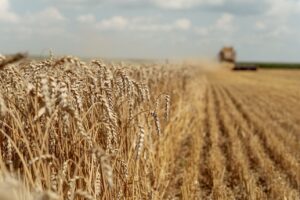
As of August 22, farmers harvested 27.25 million tons of early grain and leguminous crops from 6.7 million hectares, which is 60% of the area sown with these crops, according to the Ministry of Economy, Environment, and Agriculture.
Last year, as of August 23, 32.02 million tons of grain were harvested from 8.0403 million hectares, meaning that this year’s figures are 14.9% and 16.7% lower, respectively.
According to the Ministry of Economy, 21.01 million tons of wheat were harvested from 4 million 873.1 thousand hectares (last year – 21.74 million tons from 4 million 858.9 thousand hectares), barley – 4.97 million tons from 1 million 304.6 thousand hectares (5.5 million tons from 1 million 399.2 thousand hectares).
The average yield of these crops this year is 4.31 tons/ha and 3.81 tons/ha, respectively, which is 3.5% and 3.3% less than last year’s figures.
At the same time, this year’s pea harvest is already higher than last year’s – 0.58 million tons from 258,600 hectares compared to 0.468 million tons from 207,600 hectares, and the yield is 12.8% higher at 2.5 tons/hectare.
Other grains and legumes were threshed on an area of 260.6 thousand hectares, with a yield of 685.3 million tons (0.83 million tons).
It is noted that among the leaders are, in particular, the Odessa region, which harvested 3.44 million tons from an area of 1 million 083.4 thousand hectares, Kirovohrad region harvested 2.20 million tons from an area of 533.4 thousand hectares, and Vinnytsia region harvested 2.385 million tons from an area of 423.7 thousand hectares.
According to the ministry, as of August 22, the rapeseed harvest amounted to 3.163 million tons from an area of 1 million 283 thousand hectares, while last year on August 23, it amounted to 3.36 million tons from 1 million 227.7 thousand hectares, and the average yield is 7% lower than last year’s on this date and amounts to 2.5 tons/ha.
Sunflower harvesting has begun in the Dnipropetrovsk and Odesa regions, and soybean harvesting has begun in the Kharkiv region.
As reported, in its Inflation Report published at the end of July, the National Bank of Ukraine lowered its forecast for this year’s grain harvest from 61.7 million tons to 57.9 million tons, and for oilseeds from 22 million tons to 21 million tons.
The NBU recalled that last year, the grain harvest in Ukraine fell to 56.2 million tons from 59.8 million tons in 2023, while oilseeds fell from 21.7 million tons to 20 million tons.
According to forecasts by Deputy Minister of Economy Taras Vysotsky, this year’s grain harvest will be around 56 million tons, the same as last year.

The historic Qutub Minar tower in New Delhi was illuminated in blue and yellow on the evening of August 23–24 in honor of National Flag Day (August 23) and Ukraine’s Independence Day (August 24). The event became a symbol of solidarity with the Ukrainian people; photos and videos of the illumination were posted on the embassy’s social media pages and website. Indian media also reported on the event: Ukrainian Ambassador to India Alexander Polischuk thanked the organizers, noting that the illumination was “another sign of support” for Ukraine;
The event took place despite the rain.
Previously, similar Qutub Minar lighting events were held on international dates and anniversaries, making the monument one of the venues for public diplomacy in the Indian capital.

In July 2025, Ukrainian metallurgical enterprises produced 581,000 tons of steel (down 18.1% year-on-year and down 6.4% month-on-month), ranking 23rd in the Worldsteel rating of 70 countries. In January–July, production amounted to 4.263 million tons (–7% y/y), with Ukraine ranking 22nd for this period.
According to Worldsteel, India, the US, Turkey, and Iran showed growth in July compared to last year, while the other countries in the top 10 recorded a decline.
The World Steel Association is an international association of the steel industry, bringing together steel producers, national and regional industry associations, and research institutes; its members account for about 85% of global steel production. Its headquarters are in Brussels, and it has an office in Beijing. The organization was founded in 1967 as the International Iron and Steel Institute and was renamed in 2008. Worldsteel regularly publishes monthly production statistics and an annual reference book, World Steel in Figures.

In July 2025, global steel production amounted to 150.126 million tons, which is 1.3% less than in July 2024.
According to the World Steel Association (Worldsteel), the top ten countries are as follows:
China — 79.660 million tons (-4% y/y)
India — 14.000 million tons (+14%)
United States — 7.142 million tons (+4.8%)
Japan — 6.918 million tons (-2.5%)
Russia — 5.700 million tons (-2.4%)
South Korea — 5.256 million tons (-4.7%)
Turkey — 3.182 million tons (+4.2%)
Brazil — 2.930 million tons (-5.5%)
Germany — 2.719 million tons (-13.7%)
Iran — 2.235 million tons (+29.7%)

Romania is the most accessible country in Europe for digital nomads, according to a study by Omio. The index looked at the cost of living, rent, visa requirements, and internet access, with interest in remote work across borders growing fast.
Romania ranked first among European countries in terms of accessibility for digital nomads. Its assets include the lowest cost of living (index 37) and favorable rental conditions (index 7), which are significantly lower than in the US (72).
However, to obtain a digital visa in Romania, you need to prove that you have a monthly income of at least £3,700 (~$5,000), which is a high threshold for many freelancers.
In second place is Albania, which has the same low cost of living and rent but a more lenient income threshold (€1,000), although it lags behind Romania in terms of safety and internet speed.
Georgia is one of the leaders in terms of low living and rental costs, but its mandatory income requirement for a visa — around £2,000 — is higher than in Albania.
Hungary also ranks highly in the regional rankings thanks to its fast internet speeds and moderate income requirements for a visa.
Omio’s research confirms Eastern Europe’s status as the most accessible region for digital nomads. Romania leads the way thanks to its favorable combination of cost of living and infrastructure quality. However, visa requirements — particularly the relatively high level of provable income — remain a barrier for effective freelancers with unstable incomes.

Norway is allocating approximately NOK 7 billion (US$696.12 million) to finance air defense systems for Ukraine, according to a press release from the Norwegian government on Sunday.
“Together with Germany, we will ensure that Ukraine receives powerful air defense systems. Germany and Norway are working closely together to support Ukraine in defending the country and its civilian population against Russian air attacks,” Norwegian Prime Minister Jonas Gahr Støre said.
It is noted that Norway and Germany are financing two Patriot systems, including missiles. In addition, Norway is contributing to the purchase of air defense radars from German manufacturer Hensoldt and air defense systems from Kongsberg.
“Air defense is crucial for protecting military units and infrastructure. Together with Germany, we are now stepping up our efforts even further,” added Defense Minister Tore Rømmers.
Earlier this summer, German Chancellor Friedrich Merz and Støre agreed to transfer two Patriot systems to Ukraine, which are currently in Germany and will be delivered to Ukraine as soon as possible.
The US has confirmed that it will replace the transferred systems, and Norway has pledged to make a financial contribution to their replacement.